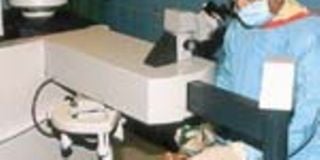Two minute surgery to put away eyeglasses

Dr Mukesh Joshi attending to a patient using the new laser refractive eye surgery technology which was installed for the first time in the coutry last month.

Dr Mukesh Joshi attending to a patient using the new laser refractive eye surgery technology which was installed for the first time in the coutry last month.
One of the most advanced eye correction technologies – which eliminates or reduces dependence on glasses – is now available in Kenya.
The laser refractive surgery means that people using glasses to correct eyesight can resort to their naked eyes once again and for life. This is after undertaking a two to five minutes procedure to correct their eye problem be it near or farsightedness or astigmatism - a condition in which the cornea of the eye is asymmetrically curved, causing distorted vision.
According to Dr Mukesh Joshi, the medical director of of Laser Eye Centre at Sarit Centre, which also introduced the technology to Kenya, refractive surgery has worked in 50 countries worldwide, where over two million people have already benefited from it.
"This is a relief for people in Eastern and Central African region, who have always have had to travel to Europe, United States or South Africa for the surgery," said Dr Mukesh, during the installation of the surgery machine in Nairobi last month.
Dr Mukesh has spent six years training in refractive surgery otherwise known as LASIK, in various centres around the world.
The Germany made Wavelight machine is the first such in the region. "The technology is simple," says Dr Mukesh. "People wear eye glasses because their eye lenses and cornea cannot focus the light at the retina of the eye, where the final focus of the rays of the light occur and are then transmitted to the brain. The external lenses in the eyeglasses are therefore used to refract the light from a given focal length, to allow it land at the retina as expected," explains the doctor.
However, in refractive surgery, a thin slice of the cornea (the thickness of a contact lens) is lifted using a microkeratome. The cornea is shaped accordingly, that is, it is flattened if the patient is myopic (short–sighted), steepened if the patient is hypermetropic (long–sighted) and reshaped in astigmatic patients (patients whose corneas are oval in shape).
LASIK surgery therefore utilizes the accuracy and precision of the excimer laser to change the shape of the cornea to improve the way light is focused or refracted by the eye.
"The patient feels no pain, and the procedure takes approximately two to five minutes to complete before the patient resumes the normal eye blinking with already corrected eyes."
To achieve this, the laser beam is aimed at the middle of water layer called stroma, where there are no corneal nerves. As a result, there is no nerve interaction in the process, thus no pain is felt.
However, the patient must go through a compulsory consultation, which is offered free of charge at the clinic. This is a very important session because we use it to conduct the pre-operation check up, and after the surgery, we must take the post-operation check up, says Dr Mukesh.
The check ups are used to conduct the patient’s corneal mapping to determine the topography of the patient’s eye. Pre existing retinal degeneration cannot be prevented by the Lasik procedure. Most patients who are short sighted have a tendency of retinal degeneration, which cannot be prevented by the LASIK surgery, says Dr Mukesh.
The operation is however only fit for persons above 18 years of age, who are not diabetic and must be free from HIV. They should also not have rheumatoid arthritis, glaucoma and should not have extremely dry eyes. Kenya is now the third African country to have the technology others are South Africa and Egypt.




